In the Jaws of Justice (with Podcast)
Collective intelligence, the climate crisis, and the remarkable trial of the Barclays Seven.
Resonant World #48
Shortly before 7 a.m. one Wednesday in April, 2021, Sophie Cowen and six other women emerged from the crowds of commuters swarming through the tube station at Canary Wharf, a financial district in east London, and made the short walk to the headquarters of Barclays bank, one of the world’s biggest financiers of fossil fuels.
Dressed smartly, Sophie could easily have passed for one of her former colleagues at the nearby law firm where she’d worked eight years earlier. The only outward clue that something had changed was her pandemic mask: stitched in the purple and green colours of the Suffragettes. Sophie had also updated the contents of her handbag, which now included a lump hammer and a bladed woodworking tool called a bradawl — both of which she’d painted bright pink. She had added the words “Act with Love” in black letters on the hammer’s handle, and “Care” on its oblong-shaped head.
Sophie reached a spot near the main entrance to the Barclays building, placed the sharp edge of the bradawl against a pane of glass, and carefully lifted the hammer to strike. A web of tiny cracks appeared — an effect mirrored in the panes where the other women had also begun delivering measured blows with their own custom-painted tools. A few minutes later, the seven sat down and calmly awaited arrest.
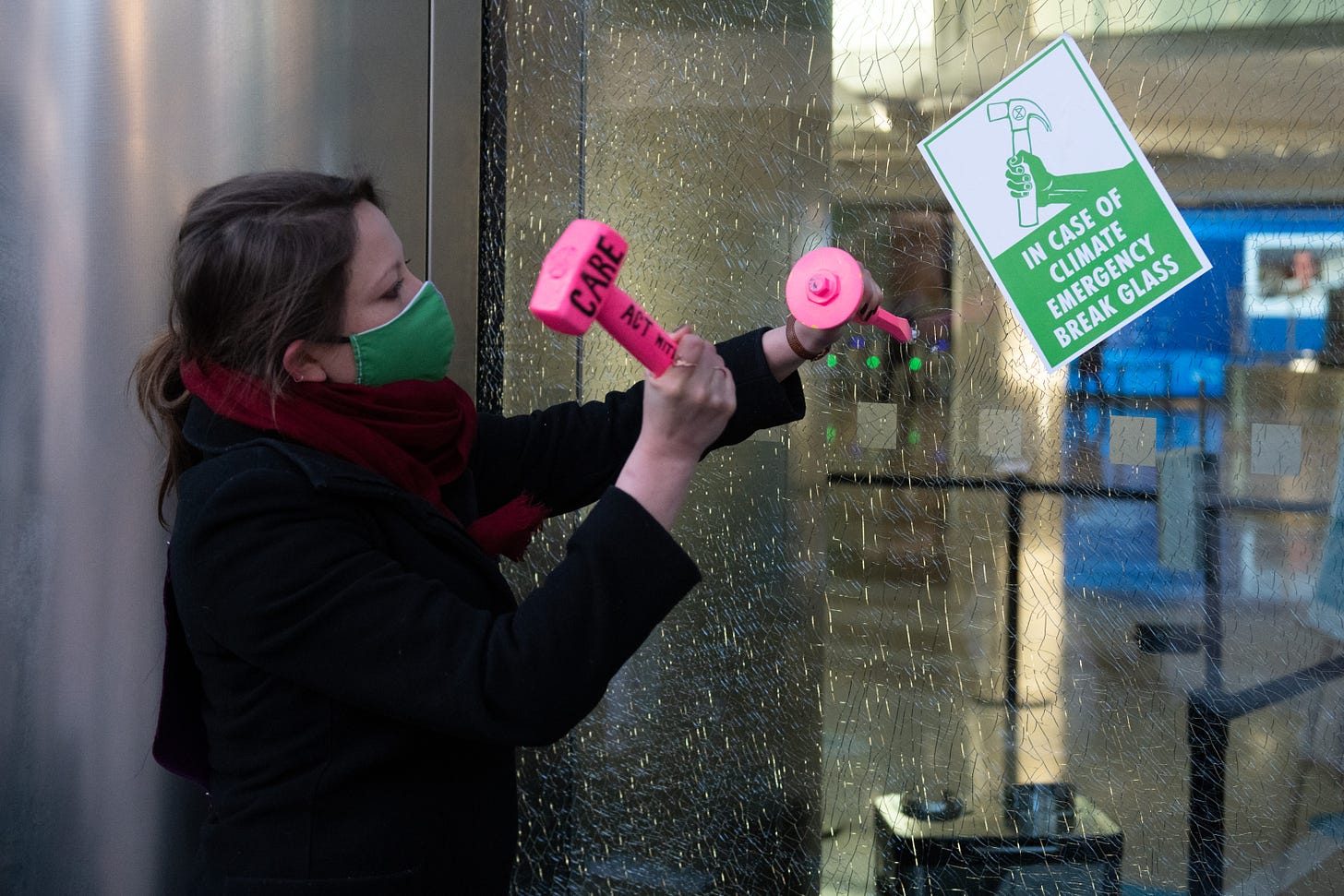
Police handcuffed the women; placed them in a police van, and drove them to a police station, where they were given gray tracksuits to wear, and locked in cells. Sophie was released at 3 a.m. that night, but it would be another two years before she and her co-defendants Rosemary Annie Webster, Cazzie Wood, Gabby Ditton, Lucy Porter, Zoe Cohen and Nicola Stickells would learn their fate. With the windows valued at £100,000, the “Barclays Seven” faced possible sentences of up to four years in prison.
Deeper Dialogue
I’d met Sophie in early 2019, while working on a cover story for the Financial Times weekend magazine on Extinction Rebellion. She’d been volunteering in the movement’s media team — having left a stint in the advertising industry to pursue work more aligned with her values. We reconnected earlier this year, several months after the conclusion of her trial, and I felt a strong call to engage in deeper dialogue over her experience of civil disobedience, and the new perspectives she’d gained.
The conversation we recorded on July 6 with Jacob Kishere for his SENSESPACE podcast is available to watch here, and listen here. I loved the transmission that came through as Sophie spoke with such precision about her embodied experience of acting in alignment with her appreciation of the dire peril the climate crisis represents. I could really feel the incredible energy that her stance had liberated, both in herself, and the many people moved in less direct ways by the Barclays action, and countless other acts of civil disobedience inspired by Extinction Rebellion, and related movements, such as Just Stop Oil and Insulate Britain.
Having reviewed our dialogue, I felt an impulse to think aloud about how the concepts I’ve been exploring in collective trauma work might map onto Sophie’s experiences — and the phenomenon of climate civil disobedience more broadly. These questions are central to the inquiry into possible relationships between the climate crisis, collective trauma and pathways to integration that drive Resonant World. (Resonant World #38).
“Field Thinking”
In his 2020 book Healing Collective Trauma: A Process for Integrating our Intergenerational and Cutural Wounds, Thomas Hübl draws on decades of facilitating large group processes to describe the collective intelligence that starts to arise when people have established a sufficient sense of relatedness, safety and trust. (Resonant World#47).
Where individuals may have previously tended towards habitual, conditioned patterns of thinking and relating, this process of building what Hübl calls “coherence” allows access to deeper levels of insight and innovation — as if the group has become a conduit for an evolutionary impulse to reach into reality, and start to reshape it.
“I refer to this quality as field thinking, a kind of systems processing that allows us to see not only ourselves and one another but our points of overlap and interconnection as an energetic whole,” Hübl writes.1
I’ve experienced this phenomenon first-hand during the in-person and online retreats I’ve attended as part of the two-year Timeless Wisdom Training programme that Thomas runs to teach the principles of integrating individual, ancestral and collective trauma. By its nature, the work brings traumatic material to the surface — and I’ve felt old wounds being triggered. But it’s what happens when so many people simultaneously bring these micro-processes into awareness that’s so powerful: Individuals begin to speak, and act, from a level of depth, generosity and courage that would be hard to imagine on the first day the group convenes. (Resonant World #10).
Looking back on my experiences of reporting on the early days of Extinction Rebellion, just before the movement achieved global prominence by occupying iconic sites in central London in April 2019, I suspect that I’d been sensing potent expressions of that quality, before having the language to name it. Even the chain of events that cleared the path for me to write about the movement for the Financial Times seemed to exhibit an unusual quality of flow. Somehow, and perhaps only briefly, the movement seemed to be activating similar chains of serendipity at every scale, from the unlikely coup of securing Oxford Circus — a busy thoroughfare — with the help of a pink sailing boat, to countless individual acts of courage and care.
“Beyond Logic”
At that time, Sophie had only recently returned to London after spending a year in India, where she’d engaged in deep meditation practice. The profound sense of interconnectedness that she’d accessed had felt elusive in the confines of the city, and — looking for inspiration — she’d found her way to an Extinction Rebellion meeting.
“I turned up in this room of all these people that are embodying: “We’re going to act with compassion, and we’re just going to do what feels compassionate and thriving and real.” It was the first time that I’d been in a space that felt like that state of full alignment with the Universe; with the world; with all that lives, that I’d been experiencing when I was in states of deep meditation…There was this energy of love — it was just vibrating in the room. It went beyond logic. It was: ‘This feels good.’”2
There are many possible frames that could be used to analyse the strengths and weaknesses of Extinction Rebellion as a protest movement, but to me, Sophie’s description sounds very much like an account of the kind of palpable group field that can emerge during collective trauma work. It was this field, it seemed to me, that had inspired hundreds of people — many of them first-time activists — to offer themselves for arrest, by blocking roads, or staging more dramatic actions. Barclays would by no means be the only bank in need of new windows: Groups of women activists would also crack panes at HSBC and JPMorgan. The combination of these and many other actions catapulted the urgency of the climate and ecological crisis into the public imagination in a way that decades of conventional environmental advocacy had come nowhere close to achieving.
The question I’m left with is how far Extinction Rebellion — particularly in its initial stages, and for all its setbacks and missteps — was an authentic expression of an underlying collective intelligence that was emerging in response to these crises. And if so, was the energy that Sophie, myself and many others, sensed in those group spaces a sign of the presence of some deeper evolutionary impulse that was seeking to help us essentially save ourselves, from ourselves?
“So Vibrant”
What was equally striking to me was Sophie’s description of the sense of aliveness that she had felt during actions — regardless of the consequences she might face, whether for cracking a window at Barclays; protesting at an airport, or chaining herself to the railings at parliament.
“Everything becomes so vibrant, like the colours of the departure gate, or the railings, or the gates as you go out of the tube….Right and wrong is a difficult duality to work with: For me it was acting in compassion — acting in a way that is congruent with the state of affairs. And it’s fully non-violent, and it’s fully mischievous. It’s breaking through this paradigm, and in doing that everything is so vibrant. It’s amazing how much my Being, my body, was flourishing in those moments…I’m looking outside at a pavement at the moment, the cracks in the pavement: There are things pushing through, they’re going: “I’m coming through, I’m doing what I need to do to support Life to thrive.”
In so many respects, Sophie was ideally equipped to pursue conventional definitions of success within the existing system. But something had shifted. (Resonant World #35)
Vertical Connection
Though Sophie had been focused on the upcoming Extinction Rebellion protests when we’d first met, I’d always wondered about the connection between her months of meditation practice in India, and her turn toward activism.
My interest stemmed in part from my own powerful experience on a 10-day Vipassana retreat in northern India in 2011. The opening I’d undergone was in many respects a catalyst for me to return to the UK and write a book about trauma among British military veterans, which would ultimately lead me to Thomas Hübl’s work, and the birth of Resonant World.
Likewise, I experienced a deep process on a seven-day silent retreat as part of the Timeless Wisdom Training this March (Resonant World #21). Although I’ve never been arrested, I’d maybe felt a trace of the energy Sophie had described a few weeks after that silent retreat, when I stepped outside of the bubble of conformity usually maintained by members of my former tribe of Reuters journalists to publicly confront the company’s decision to host conferences designed to accelerate production of oil and gas. (Resonant World #33)
From a spiritual perspective, meditation can open up our capacity to connect to a more universal form of intelligence (the vertical) that can infuse our actions in the everyday world (the horizontal). It struck me that as Sophie’s vertical connection had strengthened exponentially on retreat in India, so had her relationship to the horizontal plane changed radically when she’d returned to the UK. Put another way, Sophie’s meditation practice had synchronized her life more closely with her soul.
Transgenerational Resources
Another key element of collective trauma work also seemed present in Sophie’s account: ancestral resources (Resonant World #27).
Working to integrate trauma as individuals, we will inevitably encounter the painful imprints that live on in us from previous generations. But we can also work to access the resilience, creativity, family culture, entrepreneurial spirit and many other gifts our ancestors may have bestowed.
Sophie’s story was a reminder of the scope for accessing collective ancestral resources in response to collective challenges — such as the courage and commitment to justice that fueled the Suffragettes’ struggle for women’s voting rights; part of the inspiration for the Barclays Seven’s choice of window-cracking as a language of protest.
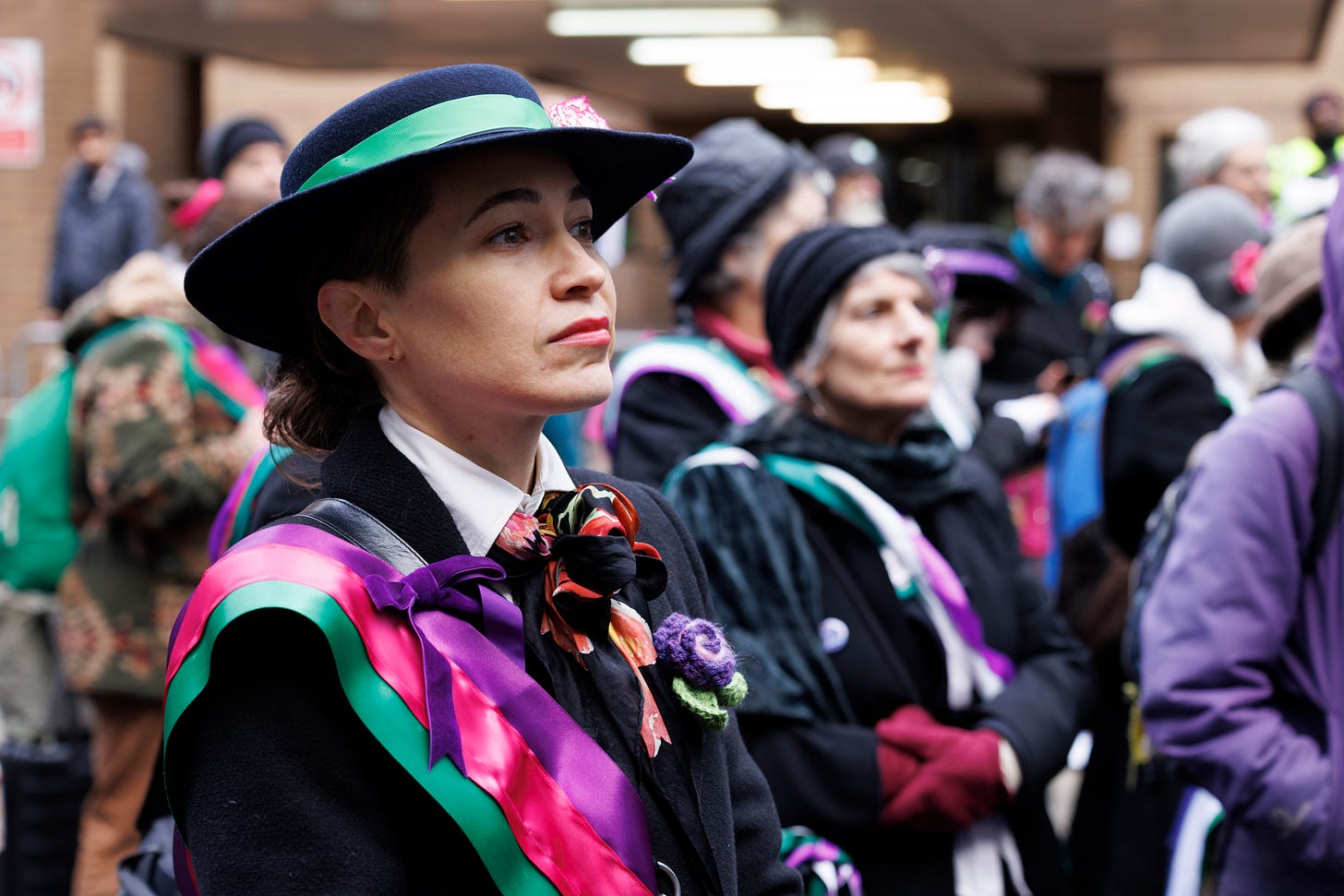
“A Simple Choice”
While waiting to stand trial at Southwark Crown Court, Sophie had been supporting her partner James Thomas through his own trial and two-month imprisonment for breaching an injunction against blocking the M25 motorway outside London as part of climate protests staged by Insulate Britain. Sophie said:
“Watching the one you love being taken away into the dock by the prison guards is a gut-wrenching experience. I had no idea how he would cope in prison, whether he would be safe, how he would deal with being cooped up for hours, days on end, with barely any outside space or sunlight.”3
When it came to Sophie’s trial, James’ was a mountain of strength — the core of a wider support network of friends and family who transformed the individual experience of each of the Barclays Seven into a collective ordeal.
“The mirroring of our experiences — being on trial for actions we were proud of and knew were necessary — helped us both to work together to get through it, and to process the fear of separation.
“He understood like no one else could what I needed. Whether it was the practical — food, water, help with self-representation, a hug — or the emotional: the glances, the strength, just holding me close when I felt like a shell of a human. He knew what I needed, and, given that we’d been through a similar process a year earlier, we knew how to do it together, or at least, we knew how to be comfortable in the unknown, and be each other’s rocks.”
The Barclays Seven laid out the science of climate breakdown, and the role of Barclays and other banks in financing fossil fuels, before the court. The stark reality of our global predicament drove some jury members to tears. But there were lighter moments as well, such as when the clerk produced Sophie’s pink hammer.
“The judge could have been my dad or my grandfather, [he] looks quizzically at it, and is almost stifling a laugh. It’s like Monty Python. Is this real? Am I really here? Is he really wearing a wig? The theatre of the whole thing.
“On the other side, we are actually laying out our hearts and souls, to a point where I couldn’t eat. You really feel like the weight of the world is on your shoulders: You’re there in the jaws of justice, and desperately trying to speak to these people as humans — because we are all humans in this, with our weaknesses, just trying to connect.
“You could just feel the juxtaposition of those absurd, almost comedic moments, and this desperate, open love: Laying [the climate science] out because there’s nothing else; this is it; everything is falling apart…You’ve got the jury members crying, the judge staring down at his papers. It’s like a microcosm of the strange society that we find ourselves in.
“When it came to the sentencing, I said to the judge: “If we’d met in a different situation, and you weren’t in your role as judge, and I wasn’t in my role as defendant, and I asked you to step into your role as father, as brother, would you condemn us for this action? Given the last two weeks, and what you’ve heard?’
“He said: ‘Ms Cowen, you’ve already stated your protest, this is about the law and the law simply.’ And I said: ‘Your Honour, if we follow the law in its current form, everything on Earth is going to die.’
“I was sitting quite near him, and I could feel there was this slight shake, and this slightly strange feeling in the room. Because it was moments like that where you’re going: ‘Come on guys, let’s pull ourselves out of our roles here and choose what we want to do.’
“For me, that is a lesson for myself moving forwards, and for anyone that I hope to encourage and support: To really think and feel as to whether the roles we were given by someone else, or that we’ve chosen to step into because it’s our career…. Are those roles actually supporting Life to thrive? Or is it just another day at the office?”
After two days of jury deliberations, Sophie and her co-defendants were found guilty of criminal damage. They would have to wait another two months — until January 27 this year — to learn whether they would go to prison.
That day, a crowd of about a hundred supporters — many dressed as Suffragettes in long coats and wide-brimmed hats — marched Sophie and her co-defendants to Southwark Crown Court, where the public gallery overflowed with friends and family. The seven women had brought packed wheelie bags, ready for jail.
Whoops and cheers erupted as they were handed suspended sentences — meaning they were free, provided they didn’t break the law within the next two years. For women who had been expecting to go to prison — or at least face heavy fines, community service and curfews — it felt like their unflinching presentation of the reasons for their actions had been heard. By not punishing them more severely, the judge had taken a quietly radical step, in Sophie’s eyes.
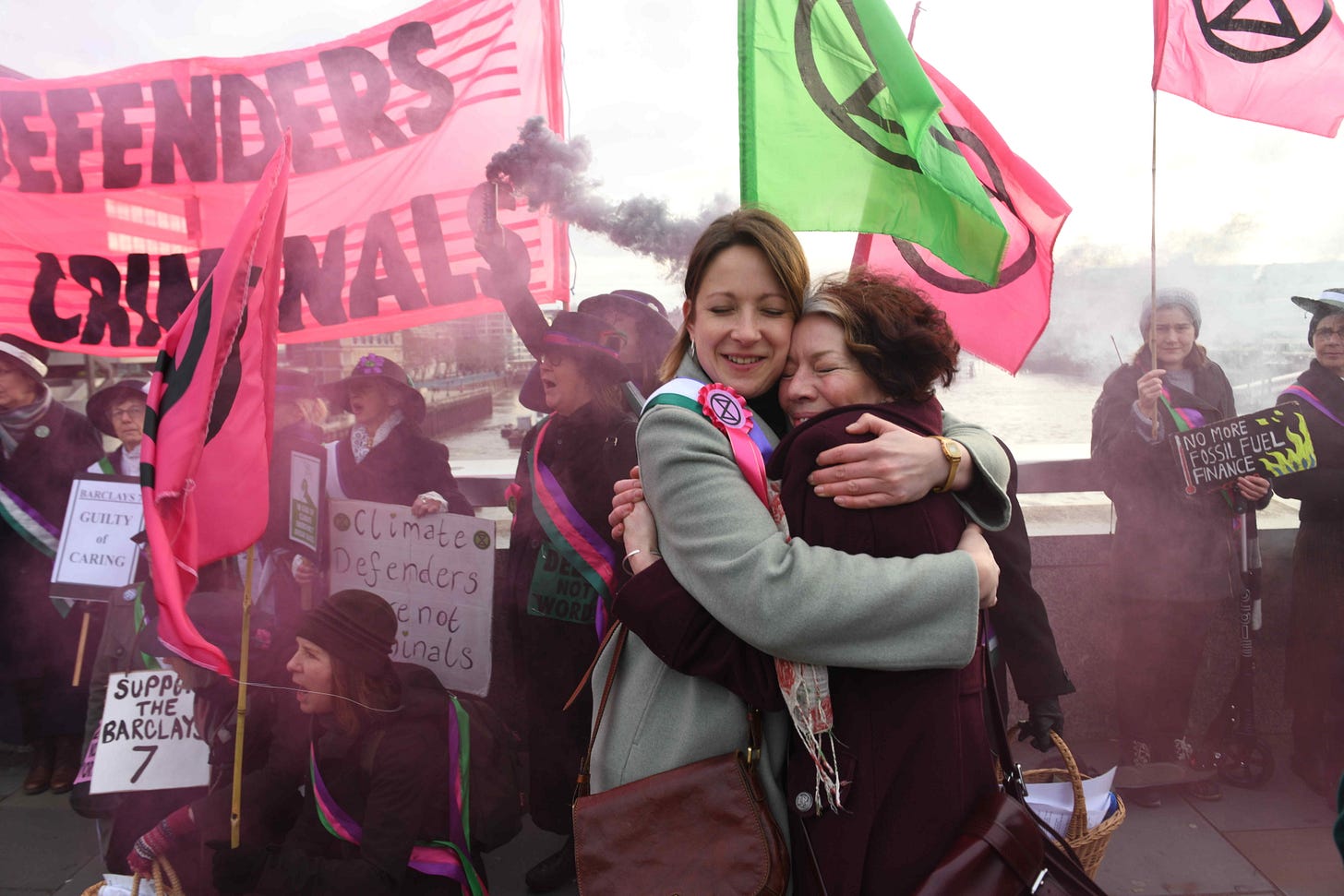
The prospects for other climate activists having a chance to lay out climate science before juries have all but evaporated since the Barclays Seven trial.
In the past year, the UK government and judicial system has has effectively quashed the right of climate activists to explain the reasons for acts of civil disobedience to juries, while giving police ever more draconian powers to crack down on protests — an ominous response that has received mostly perfunctory coverage in the media.
There may be much to be learned by assessing the state’s increasingly authoritarian stance through the lens of collective “trauma architecture”, but that’s a project for a future edition. For now, I invite you to hear this story in Sophie’s own words — and support Switch It Green, a campaign she co-founded in 2020 to catalyze a critical of mass of people to close their accounts with Barclays and other fossil-friendly banks in boycotts reminiscent of the campaign against apartheid.
Sophie told our podcast:
“It’s incredible what you feel you can do when you just take that little leap into: ‘I’m going to act in line with supporting Life to thrive.’ It’s quite a simple choice: It might not have simple consequences, but it’s certainly a very nourishing choice.”
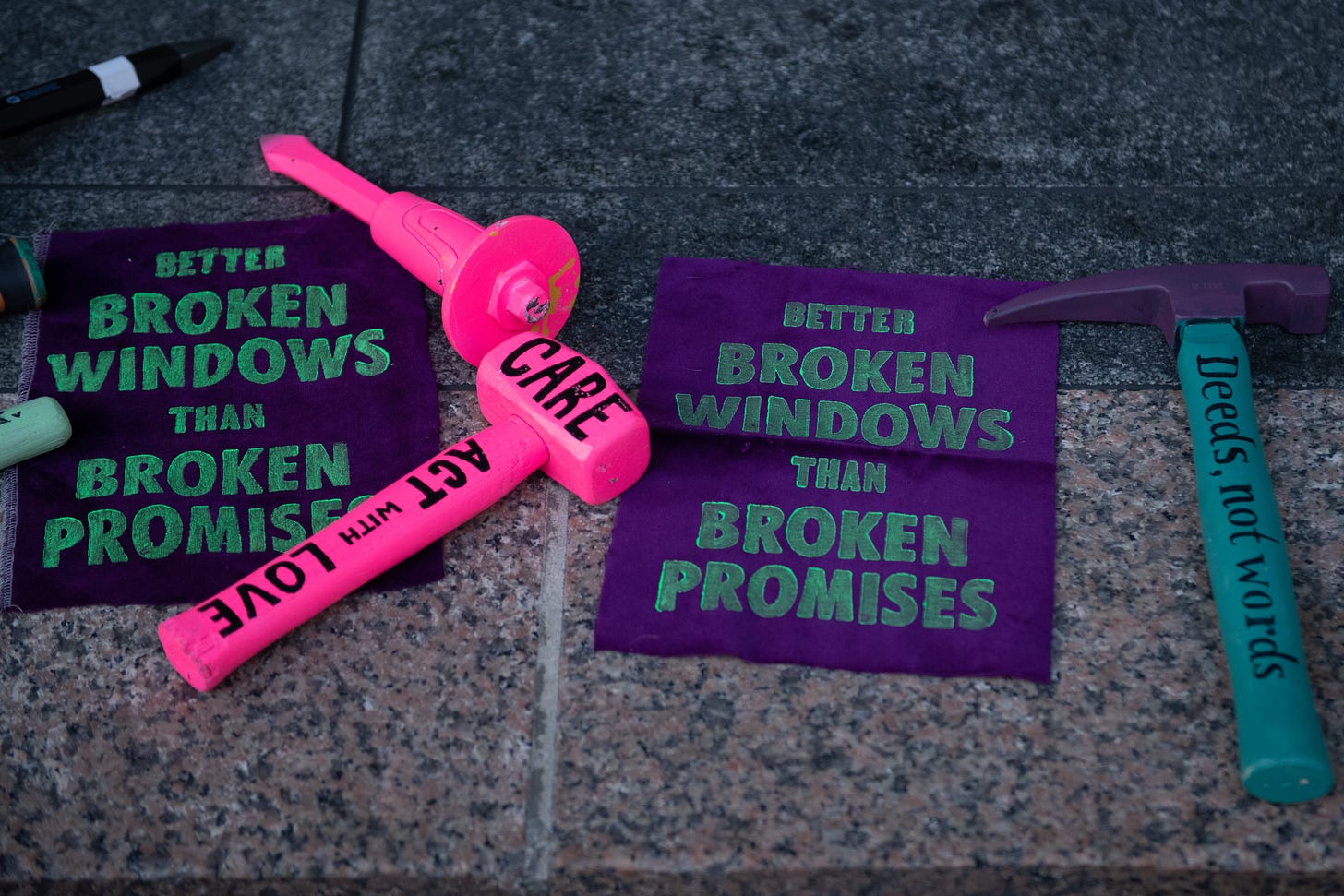
I produce Resonant World in my spare time from my role as an editor at DeSmog, a nonprofit climate news service. Any variety of coffee gratefully accepted. Thank you!
Page 221. Hübl, T. (2020) Healing Collective Trauma: A Process for Integrating our Intergenerational and Cultural Wounds. Sounds True; Boulder, Colorado.
I have paraphrased and lightly edited Sophie’s quotes from the podcast.
These lightly edited quotes were sent in an email follow-up to our podcast.




